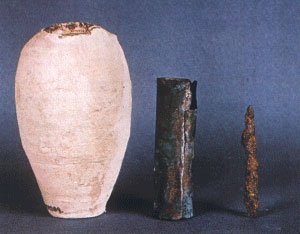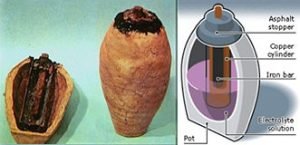
In an ancient tomb southeast of Baghdad, near Khujut Rabu, in 1936 the Baghdad Battery, also known as the Parthian Battery, was discovered. This voltaic device is an excellent illustration of how science questions the findings of operations ancient lost technology.

Estimated to be from around 2500 BCE the artifact was discovered by workers excavating for a modern train track in the region. In 1938, then director of the Baghdad Museum Research lab, German archaeologist Wilhelm Konig stumbled across the peculiar looking device in a box in the museum cellar.
Consisting of a 14cm high egg shaped clay vase with an asphalt bung with an iron rod enveloped by a copper cylinder, when the vessel is filled with acetum or any other electrolytic solution the battery emits between 1.5 and 2.0 volts of electricity. The original use of the battery was theorized to have been for electroplating gold onto silver objects. A later theory was proposed that the battery may have held medicinal applications considering bronze and metal spikes were unearthed adjacent to the Baghdad Battery. However this medicinal use has been called into question as the extremely low voltage of the battery would not have had any affect on anything other than causing very insignificant pain.
Cynics continue to dispute that there is no evidence that the Baghdad Battery ever operated as an electric battery, despite the number of frequent experiments with replicas that demonstrate its feasibility as such. In their eyes an asphalt seal, such as that on the battery, is not ideal for a Galvanic cell, would be ideal as an airtight seal for storage over an extended period of time. Given the lack of similar discoveries to date, the problem now remains whether or not the Baghdad Battery was an isolated invention. Catastrophically, during the war in Iraq in 2003, the Baghdad Battery, together was thousands of additional incalculable ancient artifacts, was plundered from the National Museum.

For those who are skeptical of the electrical battery interpretation, another supported hypothesis, is that the vessel acted as a repository for religious scrolls, conceivably comprising of rituals of some kind inscribed on natural textiles such as Cyperus papyrus or parchment.
Given the limited amount of evidence retrieved from the excavation site, whether or not the Baghdad Battery truly was a piece of lost ancient technology remains a mystery, despite our understandings of the usage and potential of this device. We would be foolish to ignore the intelligence of our ancestors given the fact that the items were discovered next to each other and when combined form a primitive battery. Especially considering other ancient technologies which we are confident of their function and purpose.
And this post must be rewarded too.
I am here to personally thank you for your Witness vote and support.
Thank YOU
Wow
Thank you again
Glad to support you as a witness and follow you to hopefully learn more and meet some other deserving authors.
They are plenty of good authors out there posting good content like yours. I hope I have enough steem powers to share the rewards. I'm here for the long run promoting good content.
Cheers to you.
Great post @ancientknowled3, thanks!
There are a lot of finds from ancient history that are not really seriously pursued by science, and that's a real shame. There are a lot of discoveries that seem to indicate a higher level of scientific and technological knowledge in times long past, than we traditionally get thought in school. It's a good thing to keep an open mind on these matters :-)
Exactly the thinking I am trying to convey
Thanks for your comment and hope you enjoy my other articles as well
Hi @ancientknowled3!
Your UA account score is currently 0.000 which ranks you at #1121496 across all Steem accounts.
Your rank has not changed in the last three days.Your post was upvoted by @steem-ua, new Steem dApp, using UserAuthority for algorithmic post curation!
In our last Algorithmic Curation Round, consisting of 325 contributions, your post is ranked at #320.
Evaluation of your UA score:
Feel free to join our @steem-ua Discord server
WOOT!
Well thank you Mr. Bot.